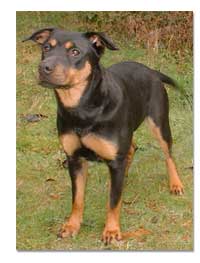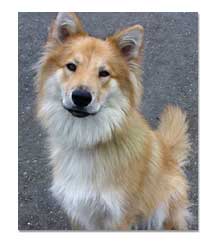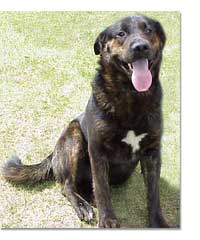 |
|
|
 |
 |
 |
Training Basics
--Written By Michael Schmidt

 Principle #1 Principle #1
Principle #1 involves the following two very simple concepts:- The dog will do things that work.
- The dog will avoid things that don't work.
This principle rules dog training. This is the most important thing to keep in mind when you begin working with your dog. If you want to encourage the dog to behave a certain way, you must make the desired behavior one that 'works" for the dog. If you want to discourage a certain behavior, you have to get the dog to understand that the undesirable behavior will not work. Most "problem" Behaviors are behaviors that "work" from the dogs perspective. If the dog senses that a certain behavior is working, the dog has little or no motivation to change what it is doing. On the other hand, if the dog senses that a certain behavior is not working, the dog is likely to change what it is doing in an effort to find behavior that works.
Principle #2
Call this the black/white principle. When we ask the dog to work, we want the dog to understand as clearly as possible that a certain behavior (the behavior we are attempting to train) "work" in that situation. We also want the dog to understand as clearly as possible that other behaviors (that are undesirable to us) do not "work" in that situation. As much as possible, we want to eliminate the gray areas where the dog is not certain what it should and should not do in that situation. The most important thing you can do to make things black/white for your dog is to be consistent in your responses to its actions. The dog will have a clear idea of which behavior works and which behaviors do not work only when it has experienced the consistent results in response to these behaviors in the past. Your job as a trainer is to make sure that the results match actions every time.
 For example, consider your first training task - teach the dog to pay attention on you. With this training you teach the dog to focus its attention on you for increased periods of time. You start by rewarding the dog (with food typically) every time it makes eye contact with you. Initially, the dog will not understand what is expected and will have no sense that there is a value in looking at you. However, by consistently rewarding the dog when it looks up at you, the dog quickly comes to realize that there is a value in looking at you. This happens quickly if you are consistent because the situation is black/white to the dog. I get food when I am looking up and I don't get food when I am not looking up. If for some reason you are not able to create a black/white situation for the dog by being consistent (you reward the dog only sometimes when it makes eye contact), the association between eye contact and the reward will be less strong and the training will take longer or fail completely. For example, consider your first training task - teach the dog to pay attention on you. With this training you teach the dog to focus its attention on you for increased periods of time. You start by rewarding the dog (with food typically) every time it makes eye contact with you. Initially, the dog will not understand what is expected and will have no sense that there is a value in looking at you. However, by consistently rewarding the dog when it looks up at you, the dog quickly comes to realize that there is a value in looking at you. This happens quickly if you are consistent because the situation is black/white to the dog. I get food when I am looking up and I don't get food when I am not looking up. If for some reason you are not able to create a black/white situation for the dog by being consistent (you reward the dog only sometimes when it makes eye contact), the association between eye contact and the reward will be less strong and the training will take longer or fail completely.
As this training progresses you want to get the dog to focus its attention on you for increasing periods of time. When you attempt to increase the time that the dog works (focuses on you), you could have problems because you enter a gray area where the dog does not understand that extended attention is now necessary to get rewarded. In Other words the dog does not understand how long it should work (focus on you). The way to make this situation more black/white is to use a clear signal that tells the dog when it is OK to stop working. With this training it is extremely important to use a release signal that clearly tells the dog the exercise is over. This way the dog is trained to work (focus on you) until you give the release signal. Once the dog understands this, it is much easier to extend the period of time that the dog is working without the dog becoming confused.
To expand this concept to other training, remember that everything you ask the dog to do is work and all work should have a beginning and an end. When you tell the dog to "stay", the command starts the work, and the release signal should be used to tell the dog it is OK to move. When you tell the dog to "heel", the command starts the work, and the release signal should be used to tell the dog that it is OK to stop heeling. Formally releasing the dog is especially important when training any exercise that involves a stay. The difficulty with these exercises usually comes from the dog not being sure how long it is suppose to stay. The release signal tells the dog in a very clear (black/white) way when it is OK to move off the stay.
Principle #3
The best way to eliminate a problem behavior is to get the dog to understand that another (more desirable from your perspective) behavior works better than the undesirable behavior. Note that this approach is different than simply getting the dog to understand that the undesirable behavior is bad. It is much easier to teach the dog how to do things than how not to do things. You should concentrate your efforts on showing the dog what you want it to do. Generally, you should not concentrate your efforts on teaching the dog simply not to do things. Usually, teaching the dog "not to" do things involves compulsion - giving the dog some form of correction (negative stimulus). Whenever corrections are used in training, the dog will experience stress. Good training involves stressing the dog and providing a way for the dog to escape the stress through a different (more desirable) behavior. The dog will be looking for ways to reduce the stress, and your job as a trainer is to show the dog how to do this. Bad training involves stressing the dog when the dog has no clear idea of what it should do to reduce the stress. Here the dog will associate the trainer with unresolvable stress and the dog is likely to decide that the only way to reduce the stress is to get away from the trainer. In other words, bad training teaches the dog to avoid the trainer.
In some cases there may not be alternative, more desirable behavior connected with the undesirable behavior. One example is teaching the dog to stay out of the trash can. In situations like this, the trainer must find a way to disassociate him/herself from the correction. The dog must somehow be made to associate the correction with the act of touching the trash (remote shock, mousetrap, etc.), and not with the trainer. If the dog associates the correction with the trash, it will probably learn to avoid the trash. If the dog associates the correction with the trainer, it will probably learn only to wait until the trainer is gone before it gets into the trash.
Remember that whenever you use corrections, it is very easy for the dog to associate you with the resulting stress. You should use corrections only when you are sure that the dog knows that it can reduce the stress it is feeling by changing to the behavior that you are attempting to train. This is why we teach the dog through motivation and not corrections. We correct disobedience. We do not correct mistakes.
 Principle #4 Principle #4
Obedience exercises should be trained as a series of small behavioral steps. The behavior steps that make up the exercise should be combined only after each step has been fully learned individually. One of the most common mistakes in dog training is attempting to train an exercise that includes two or more distinct behaviors in only one training step. If you start the training expecting the dog to do several steps before it is rewarded, you will fail and it is not because your dog is stupid. Dogs tend to associate a result (for instance a reward) with behavior that immediately precedes it. The easiest way to get the dog to understand the value in a certain behavior is therefore to reward the dog immediately when it behaves in the desired manner. If you attempt to train an exercise by rewarding only the completion of the exercise, the dog will not be motivated to learn and do the initial behavioral steps of the exercise. By training each step of the exercise individually, the dog can be rewarded immediately for successfully performing the behavioral steps that come before the final step of the exercise.
 Note that even simple exercises are sufficiently complex to require training steps. Training the dog to come to heel position is an example. Correct heeling involves both position and attention. Coming to heel therefore involves the dog moving into position, and the dog focusing its attention on the handler. With this exercise, the dog should first be taught to focus its attention on the handler. Here, the dog is rewarded (food works good) simply for focusing its attention on the handler. In this manner the dog is able to easily associate the reward with the behavior (attention) and therefore the behavior is easily reinforced. As a separate exercise, the dog is taught to come quickly into position when it hears the "heel" command. Here, the dog is rewarded immediately when it reaches the correct position. In this case the immediate reward reinforces the effort to move into position. Only when the dog is able to do both these step individually are the two steps combined to give the total exercise - come to heel and to focus on the handler. Another example of a complex "simple" exercise is the recall - to come and sit in front. In this example, the recall (come) and the act of sitting in front should be trained separately before the acts are combined into a full exercise. Note that even simple exercises are sufficiently complex to require training steps. Training the dog to come to heel position is an example. Correct heeling involves both position and attention. Coming to heel therefore involves the dog moving into position, and the dog focusing its attention on the handler. With this exercise, the dog should first be taught to focus its attention on the handler. Here, the dog is rewarded (food works good) simply for focusing its attention on the handler. In this manner the dog is able to easily associate the reward with the behavior (attention) and therefore the behavior is easily reinforced. As a separate exercise, the dog is taught to come quickly into position when it hears the "heel" command. Here, the dog is rewarded immediately when it reaches the correct position. In this case the immediate reward reinforces the effort to move into position. Only when the dog is able to do both these step individually are the two steps combined to give the total exercise - come to heel and to focus on the handler. Another example of a complex "simple" exercise is the recall - to come and sit in front. In this example, the recall (come) and the act of sitting in front should be trained separately before the acts are combined into a full exercise.
Principle #5
If you are not having fun with your dog, STOP and figure out what YOU are doing wrong. You should be having fun with your dog. |
|

